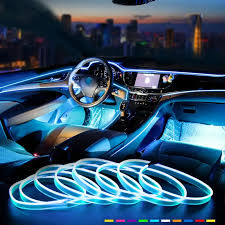
Interior Lights for a Car – Everything You Need to Know
Ever stepped into a car at night and been greeted by a soft, ambient glow that makes the interior feel almost luxurious? That’s the magic of interior lights for a car. Whether they’re for style, functionality, or safety, interior lights can completely change your driving experience.
In this guide, we’ll break down the different types, their benefits, and how to choose the right ones for your vehicle—without drowning you in jargon.
Why Interior Lights Matter
Interior car lighting isn’t just about looking good—it’s about visibility, safety, and even mood. A well-lit cabin can help you:
-
Find items easily at night without fumbling around.
-
Create a comfortable atmosphere for passengers.
-
Enhance safety by ensuring controls and storage areas are visible.
-
Upgrade the car’s look with stylish ambient lighting.
Types of Interior Lights for a Car
1. Dome and Map Lights
These are the standard lights found in most vehicles, usually positioned on the ceiling. Dome lights illuminate the entire cabin, while map lights provide focused light for reading or navigation.
2. Footwell Lights
Located near the driver and passenger foot area, these lights add visibility and style, especially when using LED strips or color-changing options.
3. Dashboard and Instrument Panel Lights
These ensure you can clearly see your speedometer, fuel gauge, and infotainment controls without straining your eyes.
4. Door and Courtesy Lights
Activated when you open a door, these lights help prevent stepping into puddles or missing a step at night.
5. Ambient LED Strips
Popular among car enthusiasts, ambient lighting adds a luxury feel. Many kits offer adjustable colors and brightness to suit your mood.
Choosing the Right Interior Lights
When picking interior lights for a car, consider:
-
Brightness Level: Too dim and they’re useless; too bright and they can be distracting.
-
Color Temperature: Soft white (3000K) creates warmth, while cool white (5000K) offers clarity.
-
Energy Efficiency: LEDs consume less power and last longer than halogen bulbs.
-
Ease of Installation: Some lights are simple plug-and-play, others require professional fitting.
-
Compatibility: Ensure the lights fit your car model and electrical setup.
Installation Tips
-
Check your car’s manual for light specifications.
-
Disconnect the battery before starting to avoid electrical shocks.
-
Use proper tools to avoid damaging panels or wiring.
-
Test before final assembly to ensure everything works.
If electrical work isn’t your strong suit, a professional installation is a safer bet.
Benefits of Upgrading to LED Interior Lights
-
Longer lifespan – LEDs can last up to 25,000 hours.
-
Lower power consumption – Saves your car battery.
-
Better brightness control – Many LED kits allow dimming or color-changing.
-
Modern look – Instantly upgrades your car’s interior.
FAQs About Interior Lights for a Car
Q1: Can I change my interior lights to any color I want?
Yes, with RGB LED kits you can choose from millions of colors—just check local laws, as some colors (like red or blue) may be restricted.
Q2: Are LED lights legal inside a car?
In most cases, yes. However, avoid overly bright lights that could distract the driver or others on the road.
Q3: How much does it cost to replace interior lights?
Basic replacements can cost under $20, while premium ambient lighting kits may range from $50 to $200+.
Q4: Do interior lights drain the battery?
Yes, if left on while the engine is off. LEDs reduce this risk because they use less power.
Conclusion
Upgrading or replacing interior lights for a car is one of the easiest and most impactful ways to enhance your driving experience. From functional dome lights to luxury ambient LEDs, the right lighting can make your car safer, more comfortable, and more stylish.